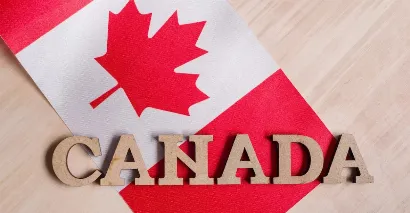Key Highlights
Canada will publish its 2026-2028 Immigration Levels Plan no later than November 1, 2025, as a first big immigration policy announcement from Prime Minister Mark Carney's administration. The plan keeps permanent resident intake at approximately 416,500 while sustaining strong decreases in temporary residents to meet housing supply constraints and infrastructure pressure.
Permanent Residency Targets Remain Steady
Canada immigration levels in 2026 will level off at 416,500 permanent resident admissions, as indicated by the Liberal government's election commitment to cap immigration at less than 1% of Canada's population per year. This is a continuation of the former government's policy to slow growth after a few years of increase, with the 2025-2027 plan already having lowered targets by 20% below 2023 levels.
The stabilisation is welcomed as Canada's population hit an estimated 41.65 million as of July 1, 2025, and represents government efforts to permit communities and infrastructure to catch up on recent population growth. The former Prime Minister, Justin Trudeau, said in October 2024: "We need to let our communities, infrastructures, catch up to the
|
Immigration Category |
2025 Target |
2026 Projected Target |
Change |
|
Total Permanent Residents |
395,000 |
416,500 |
+5.4% |
|
Express Entry System |
110,000 |
124,680 |
+13.3% |
|
Provincial Nominee Program |
55,000 |
Increase Expected |
TBA |
|
Family Reunification |
114,000 |
Expected Stable |
TBA |
Also Read: Which Province is Best in Canada? Complete Expert Guide
Express Entry System Gets Modest Boost
The Express Entry system will have a modest boost to 124,680 admissions in 2026, as per Canada immigration levels 2026 projections. The system will benefit three top candidate profiles: individuals with in-demand occupational skills, French language proficiency, and those already living in Canada with regular temporary status.
Such an orientation is a part of Immigration, Refugees and Citizenship Canada's (IRCC) promise to category-based selections that have been made in recent times. Ex-Immigration Minister Marc Miller underlined in March 2024: "As global conditions change, as our labour market tightens and as the types of skill sets we look for in our future workforce evolve, so should our policies".
The Federal Economic Priorities and In-Canada Focus categories will be given priority, enabling those existing temporary residents who are already contributing to Canadian society to become permanent residents. Between January and August 2025, more than 139,700 former temporary residents became permanent residents, accounting for half of all new permanent residents in that time frame.
Provincial Nominee Programs Set for Expansion
The Provincial Nominee Program (PNP) would be expected to get far higher quotas under Canada's immigration levels 2026 planning, reverting the 50% cut introduced for 2025. A number of provinces, namely British Columbia, Manitoba, Saskatchewan, Newfoundland and Labrador, and New Brunswick, have already signed up for additional allotments to fill regional labour gaps.
British Columbia received 1,254 more nominations for 2025 on October 2, 2025, which will go to support healthcare workers, entrepreneurs, and high economic value candidates. Yet BC still advocates for additional increases, citing that despite additions, the allocation falls short of wider priorities.
West Coast Canada is anticipated to be most positively impacted by PNP growth, since the regions continue to experience persistent worker shortages in key industries. The program enables provinces to choose skilled workers based on particular regional labour market demand, and thus serves as an important instrument of regional economic development.
|
Province |
2024 PNP Allocation |
2025 Allocation |
2026 Expected Trend |
|
British Columbia |
~9,000 |
4,000 + 1,254 bonus |
Increase Expected |
|
Alberta |
~9,750 |
Reduced |
Increase Expected |
|
Saskatchewan |
~8,500 |
Reduced |
Increase Expected |
|
Manitoba |
~6,500 |
Reduced |
Increase Expected |
Also Read: How to Get Canada Work Visa Without IELTS? Updated
Temporary Resident Caps Continue Downward Trajectory
Canada's national government intends to make drastic cuts in temporary residents with the objective of having their portion fall to less than 5% of the population by the year 2027. Temporary residents include international students and foreign workers, with the aim of having 673,650 new temporary resident admissions in 2025, which will go down to 516,600 in 2026 and 543,600 in 2027.
The strategy of reduction is already yielding fruit, as Canada has seen 278,900 fewer new entries between January and August 2025 than during the same time in 2024. These include 132,505 fewer international students and 146,395 fewer temporary foreign workers, based on significant reforms such as study permit limits, more stringent Post-Graduation Work Permit (PGWP) requirements, and more stringent work permit qualifying requirements.
The strategy seeks to integrate growth in the population with the capacity for housing, infrastructure development, and real labour market demand. Approval of study permits was limited to 437,000 for 2025, allocated by the province to handle impacts at the regional level.
Francophone Immigration Remains Priority
The focus on Francophone immigration is anticipated to continue in Canada's immigration levels 2026 planning in support of linguistic diversity and settlement beyond Quebec. Pathways for new French-speaking immigrants have been increased by category-based Express Entry draws implemented in recent times.
This focus is consistent with Canada's overall goals to enhance French-language communities nationwide and respond to demographic decline in some areas. French-language skills candidates are given preferential entry in Express Entry draws, and specialised immigration programs continue assisting Francophone settlement.
Also Read: Apply Canada Work Visa: Types, Fees, Eligibility & More
Balancing Economic Needs with Infrastructure Capacity
Immigration, Refugees and Citizenship Canada sets Canada immigration levels 2026 targets after consultations with provinces, territories, and stakeholders. The consultations take into account economic factors, labour demands, and the ability of the country to integrate newcomers effectively.
Prime Minister Mark Carney's administration is under pressure to reconcile immigration goals with a slowing economy and rising rates of unemployment. The strategy projects a net decrease of around one million short-term residents by 2027, which will give infrastructure and property markets time to stabilise.
Increased provincial nominee allocations will assist employers, especially in industries facing worker shortages. Reductions in temporary resident admissions could, on the other hand, impact sectors that rely largely on seasonal and temporary labour, such as the hospitality industry, construction, and agriculture.
|
Year |
New TR Arrivals Target |
Population Impact |
Policy Goal |
|
2025 |
673,650 |
-0.2% population |
System stabilization |
|
2026 |
516,600 |
-0.2% population |
Infrastructure catch-up |
|
2027 |
543,600 |
-0.8% population |
Sustainable growth |
Skills-Driven Immigration Takes Centre Stage
The 2026-2028 plan is part of the move towards a more focused, skill-based immigration policy in Canada. Immigration levels 2026. Category-based Express Entry selections enable IRCC to focus on certain occupational requirements, language skills, and candidate profiles that are most in the interest of Canada's economy.
This strategy ranks first the candidates who are already in Canada with temporary status, as a reward for their prior integration and contribution to Canadian society. The approach facilitates improved settlement outcomes while also filling near-term labour market needs in priority sectors.
Regional distribution is still a consideration of primary importance, with PNP growth serving to route immigration to regions facing the highest demand. The government continues to strive to enhance system performance and settlement service assistance to newcomers.
Also Read: Is 7.5 a Good IELTS Score? Here is the Truth
Conclusion
Canada immigration levels 2026 targets show an even-handed strategy in balancing population growth with filling economic requirements and infrastructure capacity. The strategy keeps stable permanent resident intakes at 416,500, increases provincial nominee programs for the purpose of enhancing regional labour markets, and keeps the aggressive temporary resident reductions to reduce their share of the population to less than 5% by 2027.
The forthcoming announcement before November 1, 2025, will solidify the specific targets and give clear direction for employers, potential immigrants, and settlement service providers across the country. For official updates on admission targets and program details, visit Canada's Immigration Levels official page published by Immigration, Refugees and Citizenship Canada (IRCC). To know more about Canada immigration, visit TerraTern now!








